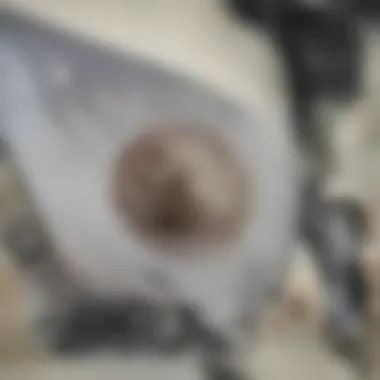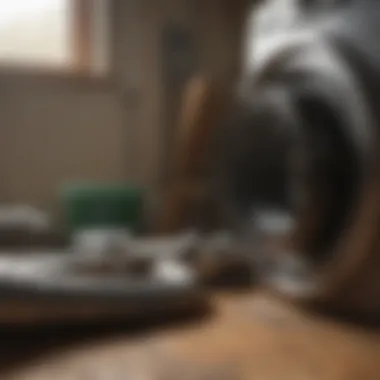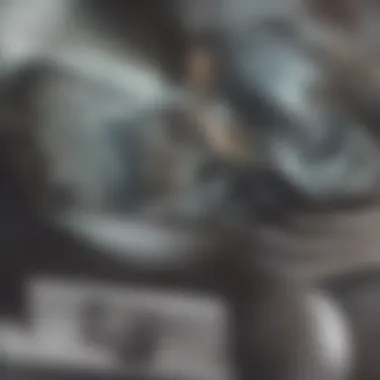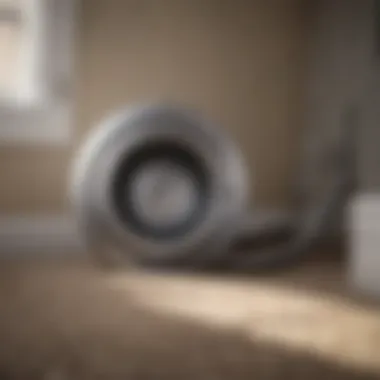A Comprehensive Guide to Dryer Vent Cleaning


Intro
Dryer vent cleaning is a necessary task that often goes unnoticed in many households. However, proper maintenance of dryer vents plays a crucial role in ensuring appliance efficiency and safety. Neglecting this essential duty can lead to several problems, including reduced performance, increased energy consumption, and heightened fire risk.
This guide aims to educate homeowners and design enthusiasts alike about the vital methods and techniques for cleaning dryer vents. By providing a comprehensive overview of the importance of vent maintenance, the necessary tools, and the cleaning process, readers will be well-equipped to handle this task effectively. Moreover, we’ll address safety considerations and discuss when it might be beneficial to seek professional assistance. Understanding these aspects can significantly enhance both the performance of your dryer and the safety of your home.
Importance of Dryer Vent Cleaning
Cleaning dryer vents is essential for multiple reasons. First and foremost, it prevents lint buildup, which is a major cause of dryer fires. According to the National Fire Protection Association, each year, thousands of fires are attributed to dryers. Regularly cleaning the vent reduces this risk significantly.
Secondly, a clean vent improves dryer efficiency. When airflow is obstructed by lint, the dryer works harder, consuming more energy and resulting in longer drying times. This inefficiency can lead to increased utility costs, thus making regular maintenance a financially sound practice.
Did You Know? Lint can accumulate in places you may not be able to see, extending the distance between the dryer and the vent exit.
Finally, maintaining a clean dryer vent prolongs the appliance's lifespan. Constant strain from overworking can wear out parts more quickly, leading to costly repairs or even premature replacement.
Key Points to Discuss
In the following sections, we will first examine the different tools and materials required for efficient dryer vent cleaning. Then, we will lay out a step-by-step process for thorough cleaning. Safety precautions will be highlighted, along with potential issues that can arise from neglecting vent maintenance. Lastly, we will cover professional cleaning options, detailing when it might be necessary to call in experts for assistance. By navigating this guide, readers will cultivate a deep understanding of dryer vent maintenance, contributing to safer and more efficient home environments.
Prelims to Dryer Vent Cleaning
Dryer vent cleaning is often overlooked, yet it is an essential part of maintaining household safety and efficiency. Many consumers underestimate the role that dryer vents play in preventing fires and ensuring that clothes dry properly. The presence of a clean, unobstructed dryer vent directly impacts the efficacy of your dryer. In this section, we explore the importance of dryer vent maintenance and the potential consequences of neglecting this task.
Importance of Dryer Vent Maintenance
Maintaining dryer vents is crucial for several reasons. Firstly, a clean vent ensures optimal airflow, which in turn enhances the efficiency of the dryer. Clogged vents can cause your dryer to take longer to dry clothes, leading to energy waste. More importantly, regular maintenance helps to prevent safety hazards. Lint buildup is highly flammable; therefore, neglecting to clean dryer vents can create fire risks in your home.
Furthermore, frequent maintenance increases the lifespan of the dryer. A dryer that must work harder due to obstructions may sustain damage over time. Keeping the vent clear can save homeowners money in the long run, reducing the likelihood of needing expensive repairs or premature replacements. It's not simply about convenience; it's about intelligent home management.
Consequences of Neglecting Dryer Vents
The repercussions of neglecting dryer vents can be severe. One of the most prominent issues is the heightened fire risk. According to the National Fire Protection Association, failure to clean the dryer is a leading cause of home dryer fires. This is not a trivial detail; it is imperative to acknowledge that ignoring dryer vent cleaning can endanger not only property but also lives.
Additionally, homeowners may experience reduced efficiency from their appliances. Clothes may remain damp after a full cycle, causing excessive wear on the dryer as it attempts to compensate for inadequate airflow. Hardly anyone enjoys the inconvenience of re-running the dryer multiple times, but this situation becomes common when vents are obstructed.
In summary, understanding the importance of dryer vent cleaning is not just a matter of preference, but a necessity for safe and efficient home management. Homeowners must prioritize this maintenance task to avoid serious consequences.
Understanding Dryer Vents
Understanding dryer vents is crucial for homeowners seeking to maintain both the efficiency of their appliances and the safety of their living environments. A dryer vent serves as the exhaust system for a clothes dryer, removing moisture and heat generated during the drying process. If these vents are not well understood or maintained, significant issues can arise, including decreased efficiency, increased energy consumption, and heightened fire risk. This section will provide foundational knowledge about the structure and function of dryer vents, allowing readers to appreciate their role in home maintenance.
What is a Dryer Vent?
A dryer vent is a duct that extends from a clothes dryer to the outside of a home. Its primary purpose is to channel hot air, moisture, and lint out of the dryer, ensuring that clothing dries properly and that excess heat does not build up inside the machine. The typical materials used for dryer vents include aluminum or flexible plastic, both designed to withstand high temperatures while allowing for some flexibility in installation.
The construction can vary, but all dryer vents typically feature a hood that opens outside, enabling the release of exhaust. Understanding that a dryer vent is more than just a pipe is vital. It plays an essential role in both the efficiency of the drying machine and the prevention of household fires. Performance can drastically decline if the vent is clogged or damaged, indicating the importance of regular inspections and maintenance.
How Dryer Vents Function
Dryer vents function through basic principles of airflow and temperature regulation. When a dryer operates, it draws in air from the room, heats it, and pushes it through clothes to evaporate moisture. This warm, humid air then travels through the vent system and exits the home.
The effectiveness of this process depends largely on two factors:


- Clear Pathway: The vent must be free from blockages caused by lint buildup or physical obstructions. If lint accumulates, it restricts airflow, making the dryer work harder to expel air. This not only increases energy costs but also extends drying times.
- Vent Design: The design of the vent impacts its efficiency. Vents with sharp bends or excessive length can impede airflow, resulting in reduced performance. Therefore, it is crucial to ensure that dryer vents follow a direct path with minimal turns.
By understanding these fundamental aspects, homeowners can better appreciate the importance of maintenance and the role of dryer vent cleaning in ensuring a functional and safe appliance. Regular cleaning minimizes the potential for dangerous blockages and enhances the dryer’s operational lifespan.
Identifying Signs of Clogged Vents
Recognizing when your dryer vents are clogged is crucial. Ignoring these signs can lead to serious consequences, including a potential fire hazard and reduced efficiency of your dryer. Knowing what to look for helps homeowners take timely action, ensuring safety and operational efficiency. This section focuses on identifying symptoms that indicate a clogged vent to empower users to maintain their appliances proactively.
Common Symptoms of Blocked Vents
Several clear symptoms can indicate that your dryer vents are blocked. Being aware of these signs allows for quicker detection and resolution:
- Longer Drying Times: If clothes take much longer to dry, it may be due to a restriction in airflow. Over time, lint and debris can build up in the vents, causing the dryer to work harder.
- Overheating Dryer: A dryer that feels excessively hot during operation is a warning sign. This can mean the heat is not being vented properly, leading to dangerous conditions.
- Burning Smell: If you notice a burning odor when using the dryer, stop using it immediately. This could indicate overheating lint or electrical components, risking a fire.
- Lint Accumulation: Excess lint collecting around the dryer or vent exit is a clear indicator of blockage. Make it a habit to check both the lint trap and the vent outlet regularly.
- Increased Energy Bills: If your utility bills rise without an increase in usage, a malfunctioning dryer may be at fault. Dryers that are clogged require more energy to function effectively.
Recognizing Reduced Efficiency
Reduced efficiency is a significant concern for both safety and cost. Observing how well your dryer performs can reveal underlying issues related to vent blockages:
- Noise Issues: Unusual sounds such as rattling or squeaking may mean debris has shifted within the vent system, causing disruption in airflow.
- Damp Clothes: If clothes come out damp or with a musty smell after a complete drying cycle, it suggests inadequate ventilation.
- Inability to Feel Airflow: Place your hand at the vent exit; if there is little or no airflow, it’s a sign that your dryer’s exhaust is blocked.
- Dryer Not Auto-Stop: Many modern dryers have settings that will stop the cycle when the clothes are dry. If this feature isn’t working, it may indicate that the machine cannot sense the dryness due to blocked vents.
Always monitor your dryer’s performance. Early recognition of these signs can save you from expensive repairs and enhance the safety of your household.
By being diligent about these signs, homeowners can address potential vent issues before they escalate. Identifying problems early not only ensures the efficient operation of your dryer but also contributes to the safety of your home.
Tools and Materials Needed
In the realm of dryer vent cleaning, having the right tools and materials holds significant weight. Proper cleaning not only enhances the efficiency of the dryer but also plays a critical role in household safety. Clogged vents can elevate the risk of fires, leading to devastating consequences. Hence, before embarking on the cleaning journey, one should ensure that all necessary tools are at hand to streamline the process.
Essential Cleaning Tools
Equipping oneself with the right cleaning tools is crucial. Here are some essential items that should be included:
- Lint Brush - A specialized lint brush can reach deep into the vent and effectively remove accumulated lint. This tool helps keep the vents clear of obstructions.
- Vacuum Cleaner with Hose Attachment - A vacuum with a hose attachment allows for the suction of lint and debris from both the vent and the dryer. This helps achieve a thorough clean.
- Duct Cleaning Kit - A duct cleaning kit often comes with several brushes and rods that can extend into the ductwork, making it easier to reach and clear blockages.
- Flashlight - Adequate lighting is essential to assess the condition of the vent and to ensure nothing is left behind during cleaning. A flashlight will illuminate any dark spaces in the vent system.
- Screwdriver - A screwdriver may be necessary to disconnect the dryer vent from the machine. It is advisable to have both Phillips and flathead screwdrivers handy.
Using these tools garantuees a more effective and safe cleaning process. Each tool serves a specific function that collectively ensures that the dryer vents are entirely cleared of dust and lint.
Safety Equipment Requirements
Safety cannot be overlooked when cleaning dryer vents. The use of proper safety equipment becomes indispensable in preventing injuries.
- Safety Goggles - Protecting the eyes from dust and debris should be a priority. Lint and other particles can cause irritation.
- Dust Mask - A dust mask is recommended to avoid inhalation of lint and other allergens that may be present during cleaning. This is important for maintaining respiratory health.
- Gloves - It is wise to wear gloves to protect the hands from sharp edges of the vent and to maintain hygiene during the cleaning process.
- Non-slip Shoes - Non-slip shoes provide stability and safety when moving around the dryer and the area where cleaning is occurring.
Approaching dryer vent cleaning with an emphasis on safety helps mitigate risks associated with this essential task. Taking these precautions emphasizes the importance of not just completing the task, but doing so safely and effectively.
"Proper preparation with tools and safety equipment is an investment in the longevity and safety of your appliances."
Finally, ensuring you have these tools and safety measures maximizes effectiveness and minimizes risk. This ensures the task is not just completed, but done with a level of professionalism and care.
Step-by-Step Dryer Vent Cleaning Process
Cleaning your dryer vent is crucial for maintaining our home’s safety. A properly cleaned vent enhances dryer efficiency and prevents potential fire hazards. This section outlines a logical process that includes preparation, necessary actions, and testing to ensure everything functions perfectly after the cleaning.
Preparation Before Cleaning


Before starting the actual cleaning, preparation is essential. This stage involves gathering all necessary tools and ensuring safety measures are set in place. You will need certain tools like a lint brush, a vacuum cleaner, and potentially a screwdriver. Ensuring you have these tools at hand simplifies the task.
- Lint brush
- Vacuum cleaner with hose attachment
- Extension cord (if needed)
- Screwdriver (if your vent is secured)
Additionally, it is wise to wear safety goggles and a mask to protect yourself from dust and lint particles. A tidy working environment allows for a smooth cleaning process and reduces accidents.
Disconnecting the Dryer
Once preparation is done, disconnect the dryer from the power source. Unplugging the dryer is crucial to prevent any accidental starts during cleaning. If the dryer is a gas model, ensure the gas supply line is turned off. After that, gently move the dryer away from the wall to access the vent adequately. This step is often overlooked but vital for a thorough cleaning.
Cleaning the Vent System
Cleaning the vent system involves a systematic approach. Start from the dryer exhaust port and work your way up the vent. Use the lint brush to dislodge lint, then use the vacuum to suck up the debris. It's important to move slowly through the process to ensure no lint is left behind.
- Use the lint brush and insert it into the vent.
- Rotate and push gently to remove lint buildup.
- Follow up with a vacuum hose to remove all dislodged lint.
Make sure to check for any blockages in the duct as well. Sometimes, items may get stuck, which could require manual removal. Regular cleaning can prevent these issues, keeping the dryer vent functioning optimally.
Reassembling and Testing
After cleaning, it is time to reassemble everything. If you had to disconnect any parts, ensure they are secured correctly. Once everything is reattached, plug the dryer back in and turn it on. This is the moment to test how well everything works.
Check for airflow from the vent outside. It should be strong and clear of any blockage. If there are still issues, it may indicate deeper problems that require further inspection.
"Regular cleaning not only prolongs the life of the dryer but also ensures that it operates safely and efficiently."
So, by following this step-by-step process, you can maintain an efficient dryer and minimize risks associated with neglected dryer vents. Keeping your home safe and your laundry routine efficient relies significantly on these practices.
Safety Precautions
Safety precautions are an essential part of the dryer vent cleaning process. Ensuring proper safety measures can prevent accidents and injuries. As homeowners, you should be aware of the potential dangers associated with dryer vent maintenance. By taking precautions, you can ensure a safer environment during and after the cleaning process.
Electrical Safety Considerations
Before starting the cleaning process, it is crucial to address electrical safety. Unplugging the dryer is the primary step. This will prevent any electrical shock while working on the appliance.
- Turn off the power: Switch off the circuit breaker that powers your dryer.
- Use insulated tools: If any tools are necessary near electrical components, ensure they are insulated to prevent shock.
- Inspect cords: Check the dryer’s power cord for wear and damage. Replacing frayed wires is important for long-term safety.
Overall, understanding the electrical components and how they function helps in preventing unforeseen issues during dryer vent cleaning.
Avoiding Fire Hazards
Fire hazards are a serious risk when it comes to dryer vents. Lint buildup is highly flammable and can ignite easily. Regular cleaning of the vent reduces lint accumulation, therefore minimizing fire risks. Here are some fundamental steps to mitigate these hazards:
- Regular inspections: Check your dryer vent at least twice a year. Look for lint accumulation in the vent and duct system.
- Correct vent installation: Ensure vents are installed according to building codes. Avoid using flexible plastic or foil ducting, as they are prone to lint build-up. Instead, opt for rigid metal ducting.
- Keep the area clear: Maintain a clear space around the dryer to reduce any fire risks. Avoid storing combustive materials near the appliance.
"Regular maintenance and cleaning of dryer vents are crucial to reducing fire hazards in homes."
By keeping these safety considerations in mind, you can significantly reduce the risk that comes with neglecting dryer vent maintenance. Taking the necessary steps ensures both your safety and the efficiency of your dryer.
Common Issues with Dryer Vents
Understanding the issues that arise with dryer vents is key for effective maintenance. Homeowners often overlook this, leading to critical operational failures and safety hazards. Regular inspection and awareness can prevent small problems from escalating into larger concerns. Here, we will discuss common blockages and excessive lint accumulation that can affect dryer performance.


Potential Blockages
Blockages in dryer vents can stem from various sources. Lint, debris, and foreign objects can obstruct airflow and reduce efficiency. Notably, lint traps are designed to catch fluff, but not all lint gets captured. Still, it ultimately travels through the vent, accumulating over time.
Some common reasons for blockages include:
- Improper vent installation: If a dryer vent is improperly sealed or too long, it may trap lint and other debris.
- Bends in the duct: Each bend in the duct can slow down and trap moisture, affecting airflow.
- Obstructions from outside: Nesting animals or leaves can block the vent outlet, especially if the exterior grill is not regularly maintained.
Addressing blockages promptly is essential. Clogged vents can lead to longer drying times and, more seriously, increase fire risks.
Excessive Lint Accumulation
Excessive lint accumulation poses a significant risk for both efficiency and safety. Lint is highly flammable; hence, its buildup can become a fire hazard. Every time a load is dried, lint escapes the trap and travels down the vent, leading to accumulation.
To minimize lint accumulation:
- Clean the lint trap after each use: This simple step prevents significant buildup and maintains airflow.
- Use a professional cleaning service: For areas that are hard to reach or are rarely cleaned, consider hiring a professional service.
- Install a lint filter: Some homeowners find that an additional inline lint filter can further prevent accumulation.
When to Seek Professional Help
Cleaning dryer vents can seem simple, yet some situations require the intervention of professionals. Recognizing when to call in experts is crucial for maintaining efficiency and safety in your home. This section discusses the complexities involved in dryer vent issues and outlines the benefits of seeking professional services.
Evaluating Complexity of Issues
Not all problems are straightforward. Some may need professional evaluation. Here are several indicators that signal when you should consider a professional assessment:
- Regular Obstructions: If you notice frequent blockages, the underlying cause could be more severe. For instance, improper vent installation or kinks in the ductwork might need reworking.
- Persistent Odors: Unpleasant smells during operations may indicate issues with the dryer or the vent system, including mold growth or additional dampness.
- Overheating: If the dryer feels excessively hot while in use, it could point to a serious blockage or malfunction. Overheating presents fire hazards, and this should not be ignored.
- Age of the System: Older vents may have accumulated years of lint that remain stuck. If the system is outdated, professionals can assess what cleaning or replacement is necessary.
If any of these problems arise, obtaining a professional's insight can offer peace of mind and appropriate solutions.
Benefits of Professional Services
Engaging with professional cleaning services comes with significant advantages:
- Comprehensive Assessment: Expert technicians possess the experience to identify issues that may not be immediately visible to homeowners.
- Advanced Tools and Techniques: Professionals use specialized equipment that effectively remove accumulated lint and debris far more efficiently than conventional tools.
- Ensured Safety: By allowing experts to handle the job, you mitigate risks of accidents caused by improper cleaning or equipment malfunction.
- Improved Efficiency: A thorough professional cleaning can restore your dryer’s efficiency, a vital aspect that often translates into energy savings.
"Regular maintenance can save homeowners both time and money in the long run."
By recognizing the right time to seek professional assistance, you ensure the longevity and safety of your dryer vent system.
Epilogue
In this article, we have delved into the nuances of dryer vent cleaning, highlighting its critical role in maintaining both efficiency and safety in households. Proper dryer vent maintenance is not merely a suggestion, but a prerequisite for ensuring that your dryer operates reliably and safely. The accumulation of lint and debris in dryer vents can lead to a significant reduction in dryer performance and a potentially hazardous situation, including the risk of fire.
Summarizing the Importance of Regular Maintenance
Regular maintenance is a cornerstone of effective dryer operation. It is not only about removing lint but also ensuring that the vent system is clear of blockages. This process helps in:
- Enhancing Dryer Efficiency: A clean dryer vent allows air to circulate freely, which enhances the machine’s performance and reduces drying times.
- Extending Appliance Lifespan: Routine maintenance reduces strain on the dryer and can prolong its life.
- Preventing Fire Hazards: According to the U.S. Fire Administration, failure to clean dryer vents is a leading cause of home dryer fires. Regular cleaning mitigates this risk significantly.
It is essential to understand that neglecting these tasks can lead to costly repairs or even replacements. The initial time and effort spent on maintenance can translate into significant savings.
Encouraging Proactive Approach to Dryer Care
Adopting a proactive approach to dryer care extends beyond cleaning. Homeowners should regularly inspect their dryer vents for signs of blockages or damage. Schedule professional cleanings at least once a year, especially if you frequently use the dryer or have a long vent system.
Implementing a routine inspection can involve:
- Checking the Outdoor Vent Cover: Ensure it opens freely during dryer operation.
- Cleaning the Lint Filter: This should be done before each load to minimize lint buildup.
- Verifying Vent Connections: Look out for loose or disconnected vent hoses, as these can lead to inefficiencies.
By taking these steps, homeowners not only enhance dryer performance but also contribute to home safety. Keeping the dryer vent clean and functional is an essential part of home maintenance that should not be overlooked.





